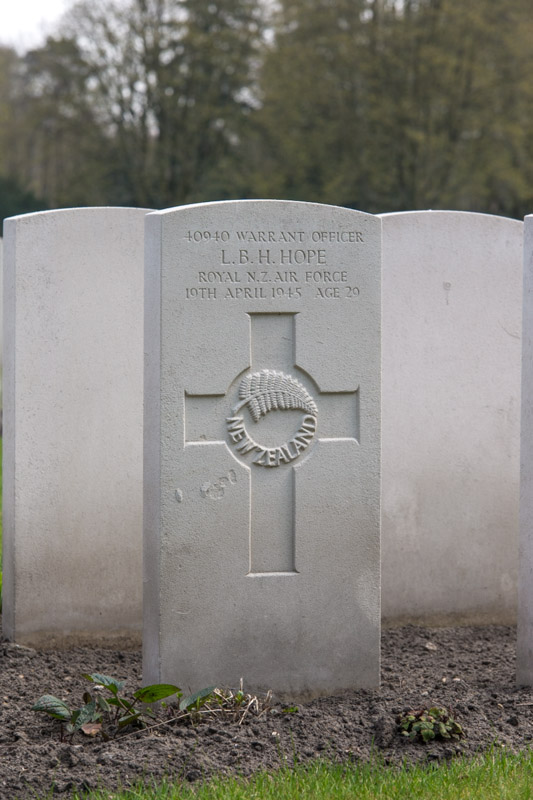Laurence Hope grew up at French Pass in the Marlborough Sounds - an isolated and beautiful place. He was born in 1926.
He is recorded as having been part of No. 2 Squadron, RAF, in 1940. 2 Squadron was an Army Cooperation unit, flying two-seater Westland Lysanders. He joined in September, 1940, after the Squadron had evacuated from France. In August of 1941, the Squadron's Lysanders were replaced with the single-seat Curtiss Tomahawk and the gunners were remustered.
Laurence became a rear gunner in No 75(NZ) Squadron, flying in a Vickers Wellington twin-engined bomber. The planes had been ordered by the New Zealand government in 1938 for use at home but, when war broke out, were immediately offered to Britain.
Laurence Hope's Wellington was shot down by flak in November, 1941, crashing near Rotterdam in Holland. Lawrence was the only survivor and was captured by German occupation forces. He was sent to POW camp Stalag 357 in Poland which was later shifted, in September 1944, to north-west Germany to avoid liberation by Russian forces.
In April 1945, Stalag 357 was evacuated in the face of advancing British and American forces. Twelve thousand men marched off in columns of 2000. They marched for ten days and arrived at Gresse, east of the Elbe river, where they were issued with Red Cross parcels. One column was mistaken by a RAF fighter-bomber squadron for a German column marching towards Allied lines and attacked by Typhoons firing cannon and rockets. It was in this attack that Laurence and 29 others died.
My usual source for blog material, "Papers Past," has no information on the fate of Laurence Hope apart from the bare information of his death. To find more I had to visit "Forum Land." Posts that I have read concerning the "Gresse incident" are of uncertain copyright so, where no copyright is asserted, I've taken the liberty of copying for Lawrence's story. I'm happy to be corrected and modify accordingly:
"The front of the column had passed into the Forest Lane, the column stretching out behind them when the sound of RAF fighters was heard. He mentions that one of the POWs had counted nine aircraft above them. Then they all watched as they peeled off. Fendon and others expected the fighters to just roar by to show their dominance of the air and many of the men did not pay any attention to the nearing fighters which made a low banking turn and disappeared in a line astern formation over the trees.
"One POW was seen to be waving at them as the aircraft swooped in low over the column and the machine guns opened fire straight into the column of men. The POWs and guards dove for what little cover there was, those quick enough to move or had help in moving. Some brave men ran out waving the RAF blue uniforms hoping to distract or signal the pilots firing on them, some lost their lives in this manner trying to stop the attack. The horse drawn carts carrying the wounded were particularly singled out by fighters." Ken Fendon's War
The following excerpts come from "rafcommands.com"
"Later this month I'm attending the 90th birthday of one of the airmen who was unfortunate enough to be straffed. He dived one side of a tree to take cover and the man next to him dived the other. He lived and the other man died. Very sad indeed. -Linzee"
"In post 9, Henk recalls an unchecked memory that he had the Typhoons as being from a Canadian squadron. In "The Last Escape," p313 in the paperback version, there is a story of some of the wounded survivors on an airfield awaiting evacuation in early May '45. They were approached by a Wing Commander who enquired after their welfare and was informed about the incident at Gresse that had wounded them and killed others, it is said that he went "ashen" and said "My God, I was leading that flight." He was identified only as a Canadian and together with Henk's recollection this might narrow any search for the Squadron among the many possibilities. I am sure that Linzee is right and it was part of 2nd TAF. -Dick"
The unfortunate victims at Gresse were buried by the local pastor, named Stube, who also compiled a list of names.
After the "Gresse incident," the Camp Leader, William Lockie, persuaded the German commanding the column to issue him with a pass and German guard to allow him to move through German lines and contact Allied forces. Lockie managed to do so and managed to have his guard released back through the line as he had promised. He was given a captured Mercedes car and drove back to the Gresse area. Two days later the column marched into freedom.
Too late for Laurence, of course.
 |
| NZ Wargraves Project |
 |
| Picton Cemetery. |
No comments:
Post a Comment